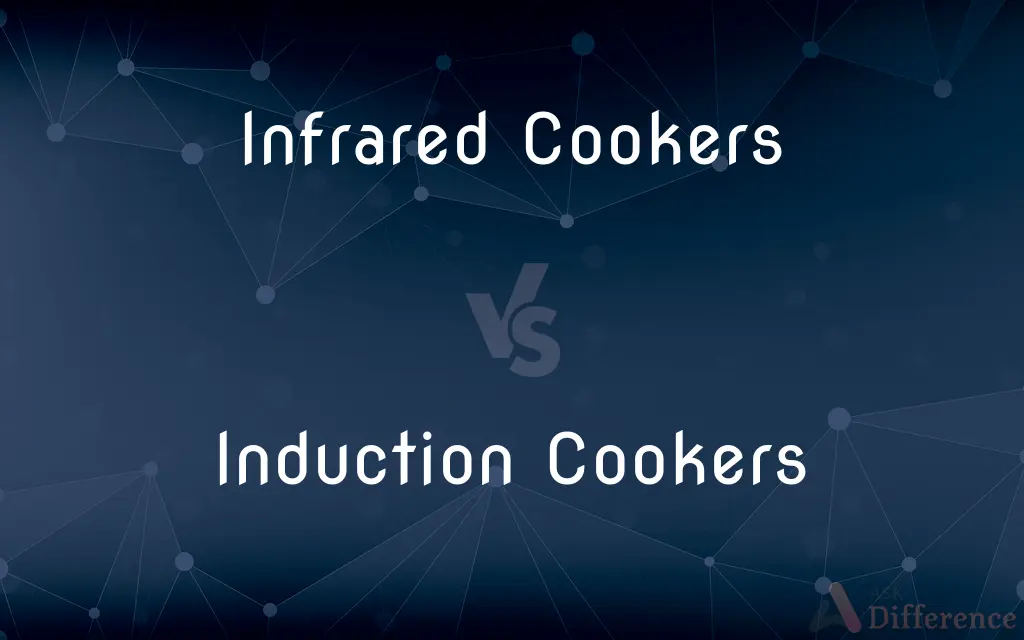Infrared Cookers vs. Induction Cookers — What's the Difference?
By Fiza Rafique & Maham Liaqat — Published on March 17, 2024
Infrared cookers use light energy to heat food directly, offering quick and evenly distributed heat, while induction cookers use electromagnetic fields to heat pots and pans, providing precise temperature control and energy efficiency.

Difference Between Infrared Cookers and Induction Cookers
Table of Contents
ADVERTISEMENT
Key Differences
Infrared cookers operate by emitting infrared radiation, which directly heats the cookware and the food within. This method allows for rapid heating and maintains a consistent temperature across the cooking surface, reducing the risk of hot spots. On the other hand, induction cookers generate heat through electromagnetic induction. When a pot or pan that is ferromagnetic is placed on the induction cooktop, an electromagnetic field induces currents in the cookware, heating it up quickly and efficiently.
The efficiency of infrared cookers lies in their ability to heat up quickly and cook food evenly, making them suitable for a wide range of cooking tasks. However, they can heat the kitchen environment, making them less desirable in warm climates. Induction cookers excel in energy efficiency and safety, as the cooktop remains cool to the touch, reducing the risk of burns and keeping the kitchen cooler.
In terms of cookware compatibility, infrared cookers can accommodate a wide variety of materials, including glass, ceramic, and metal. This flexibility allows cooks to use their existing cookware without needing special pots or pans. Conversely, induction cookers require cookware with magnetic properties, such as cast iron or some stainless steels, limiting the types of cookware that can be used.
When considering control and precision, induction cookers offer superior temperature control, allowing for precise adjustments and consistent results, especially beneficial for delicate cooking tasks. Infrared cookers, while providing even heat, may not offer the same level of temperature precision, making them better suited for high-heat cooking methods.
Lastly, in terms of energy consumption and cost, induction cookers are generally more energy-efficient, converting a higher percentage of energy into heat, leading to lower operating costs over time. Infrared cookers, while efficient, may not be as energy-saving as induction technologies, potentially leading to higher energy costs in the long run.
ADVERTISEMENT
Comparison Chart
Heating Method
Uses infrared radiation to directly heat food.
Uses electromagnetic fields to heat cookware.
Efficiency
Quick heating but less energy-efficient than induction.
Highly energy-efficient and quick heating.
Cookware Compatibility
Works with a wide range of cookware materials.
Requires ferromagnetic materials like cast iron or stainless steel.
Temperature Control
Provides even heat but less precise control.
Offers precise temperature control for delicate cooking.
Safety and Comfort
Can heat the kitchen environment; careful handling needed.
Cooktop remains cool, reducing burn risk and keeping the kitchen cooler.
Compare with Definitions
Infrared Cookers
Cooks food using infrared radiation for quick and even heating.
The infrared cooker made quick work of grilling steaks evenly.
Induction Cookers
Requires magnetic cookware for operation.
Had to buy a new set of pots for my induction cooker since my old ones weren’t compatible.
Infrared Cookers
Can cause kitchen to become warmer.
Cooking on the infrared cooker during summer adds extra heat to our kitchen.
Induction Cookers
Offers precise temperature control.
Melting chocolate on the induction cooker is foolproof thanks to the precise heat settings.
Infrared Cookers
Suitable for various cookware materials.
Using our ceramic dishes on the infrared cooker works perfectly for our casseroles.
Induction Cookers
Keeps the cooktop cool to the touch.
Even after boiling pasta, the surface of the induction cooker was safe to touch.
Infrared Cookers
Less energy-efficient compared to induction cooking.
Though my infrared cooker heats up fast, it does seem to use more energy.
Induction Cookers
Heats cookware via electromagnetic induction for efficient cooking.
The induction cooker boiled water in under a minute, showcasing its efficiency.
Infrared Cookers
Provides consistent temperature across the surface.
My infrared cooker ensures even cooking, avoiding any hot spots.
Induction Cookers
More energy-efficient, reducing operational costs.
Switching to an induction cooker has noticeably decreased my electricity bill.
Common Curiosities
How does an induction cooker work?
It generates heat through electromagnetic fields that induce currents in ferromagnetic cookware, heating it quickly and efficiently.
Which is more energy-efficient, infrared or induction cooking?
Induction cooking is generally more energy-efficient than infrared cooking.
Can I use any type of cookware on an infrared cooker?
Yes, infrared cookers are compatible with a wide range of cookware materials.
Are induction cookers faster than infrared cookers?
Both can heat up quickly, but induction cookers often heat more efficiently, leading to faster cooking times for certain tasks.
What is an infrared cooker?
An infrared cooker is a kitchen appliance that uses infrared radiation to heat and cook food directly.
Do I need special pots and pans for an induction cooker?
Yes, induction cookers require cookware made of ferromagnetic materials like cast iron or some stainless steels.
How does temperature control compare between infrared and induction cookers?
Induction cookers offer more precise temperature control compared to infrared cookers.
Is it safe to touch the cooktop of an induction cooker while it's on?
Yes, the cooktop of an induction cooker remains cool to the touch, making it safer and reducing the risk of burns.
How do I know if my cookware is compatible with an induction cooker?
Check if a magnet sticks to the bottom of the cookware; if it does, it's likely compatible.
What are the drawbacks of using an infrared cooker?
Less energy efficiency compared to induction and the potential to heat the kitchen are among the drawbacks.
How do induction cookers contribute to energy savings?
They convert a higher percentage of electrical energy into heat directly in the cookware, minimizing waste and reducing energy costs.
Can an infrared cooker be used for all types of cooking?
Infrared cookers are versatile and can be used for a variety of cooking methods, though they may not offer the precision needed for delicate tasks.
What are the main benefits of using an induction cooker?
Induction cookers are energy-efficient, offer precise temperature control, and keep the cooktop cool for added safety.
Why might someone prefer an infrared cooker over an induction cooker?
Due to its compatibility with a wider range of cookware materials and its ability to provide quick, even heating.
Can the heat from an infrared cooker affect my kitchen's temperature?
Yes, infrared cookers can raise the temperature of your kitchen, especially during extended use.
Share Your Discovery

Previous Comparison
Realists vs. Idealists
Next Comparison
Salmon vs. Sea TroutAuthor Spotlight
Written by
Fiza RafiqueFiza Rafique is a skilled content writer at AskDifference.com, where she meticulously refines and enhances written pieces. Drawing from her vast editorial expertise, Fiza ensures clarity, accuracy, and precision in every article. Passionate about language, she continually seeks to elevate the quality of content for readers worldwide.
Co-written by
Maham Liaqat















































